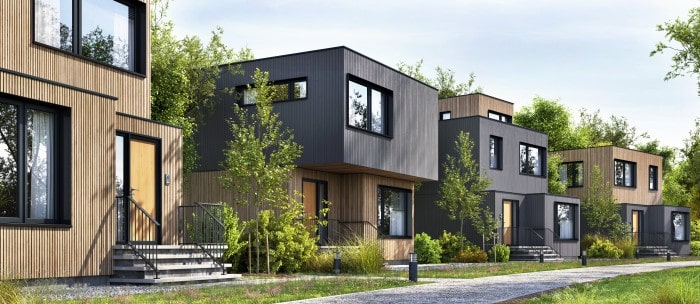
Whether you’re looking to upgrade your existing home or designing a self-build, external cladding is a worthy investment. Timber cladding can improve your living qualities with increased comfort and enhance kerb appeal to help sell your property for a profit in the future.
Exterior cladding entails applying an additional building component layer, such as timber to protect your property’s structure. Timber cladding is often divided between hardwood and softwood species, which offer distinct pros and cons and meet different requirements.
To determine whether timber cladding is suitable for your property and which type to choose, read on for the top six benefits of the home feature.
1) Eco-friendly
All forms of construction have some environmental impact but it’s important to minimise it where possible.
Unlike other cladding materials such as concrete, timber absorbs carbon rather than emitting it into the atmosphere. You can also recycle or reuse the material as bio fuel after its lifespan of up to 60 years.
Hardwood is often considered less sustainable than softwood, as it has a slow growth and replenishment rate. However, softwood isn’t as durable or long-lasting, but you can get it treated to prolong its life cycle.
International Timber, the UK’s leading importer and distributor of bespoke and sustainable timber, ensures their products are sourced ethically and aim for a full Chain of Custody.
2) Aesthetically pleasing
Applying timber cladding to your property can dramatically transform the appearance. Depending on the species and coating chosen, it can provide a modern and industrial style or a rustic charm to your home.
There are several shades of natural wood available. Softwood has a lighter appearance, and hardwood is darker, but both season to a silver-grey shade unless you preserve the colour with a treatment.
3) Superior insulation
Timber has a lower thermal conductivity than other cladding materials, such as metal, which keeps heat from escaping the property or transferring from outside into the house. This efficiency avoids wasting energy and maintains a comfortable temperature in your home.
The timber cladding’s insulation also absorbs sound, guarding your peaceful environment from loud outdoor noises.
4) Quick installation
As timber is lightweight, it’s easy and quick for a professional to install and its flexibility allows you to tailor it to a specific shape and size. Softwood is more flexible due to being less robust than hardwood.
5) Cost-effective
Timber is more economical than other cladding materials, with prices often starting at £5 per board. Softwood is cheaper initially due to it being more widely available but as hardwood has a longer lifespan, it’s often more affordable long-term.
On top of this, the simple installation process of cladding can reduce construction costs,and the energy efficiency of the material can lower your ongoing energy bills.
6) High Durability
Timber cladding withstands the impact of harsh weather elements, including rain and wind. It’s also naturally resilient to decay and insect attacks, depending on the species.
Any wear and tear produced overtime is usually hard to notice on timber cladding. It’s easy to clean and repair hardwood timber for any scratches and dents too. Although softwood is weaker than hardwood, it’s still a strong timber.
Overall, timber cladding is highly beneficial and can suit varying requirements. However, if you’re prioritising strength and durability, hardwood is a preferred solution. In contrast, softwood is ideal if speed, ease, and cost, are most important.
